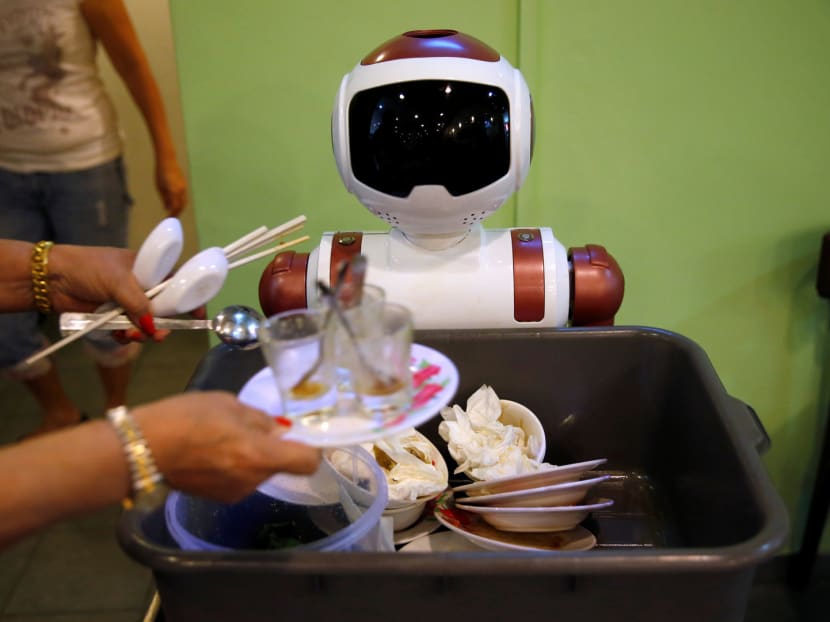In Singapore, service comes with a robotic smile
SINGAPORE — Rapid advances in artificial intelligence (AI) are feared by many in Europe and the United States, with scientists warning of mass unemployment as humans are replaced by robots. But in Singapore, where restrictions on foreign workers have left many companies struggling to find staff, service sector businesses are increasingly finding automated solutions to their workforce crunch.

A robot collecting dishes to be cleaned at Chilli Padi Nonya Cafe. The machine lacks the ability to pick up cups and plates itself. Instead customers place their used crockery in a tray it carries to the kitchen. PHOTO: REUTERS
SINGAPORE — Rapid advances in artificial intelligence (AI) are feared by many in Europe and the United States, with scientists warning of mass unemployment as humans are replaced by robots. But in Singapore, where restrictions on foreign workers have left many companies struggling to find staff, service sector businesses are increasingly finding automated solutions to their workforce crunch.
From restaurants to hospitals, robots are being rolled out in a Government-backed push to help businesses survive a tight labour market. Mr Louis Tan, chief operating officer of Mount Elizabeth Novena Hospital, said: “The Government is clamping down on foreign workers — there is difficulty in hiring even skilled workers. Technology has turned out to be one of the solutions.”
The hospital, a private medical facility run by the Parkway Pantai group, has turned to IBM’s Watson technology as an automated “nurse” to monitor patients’ vital signs in its intensive care unit.
The AI technology combines information from indicators such as blood pressure and heart rate, and uses a predictive algorithm to calculate the risk of a patient’s condition getting worse.
“In the past, that required human integration and interpretation,” Mr Tan said. “And now we are using data analytics to help drive this.” The pilot, which was launched this year, has improved patient safety, Mr Tan added. “It doesn’t mean nurses are absolved of responsibility. It just means they have another aid. It’s more efficient and safer for the patients.”
At Chilli Padi Nonya Cafe, a restaurant serving a hybrid Malay-Chinese cuisine near the National University of Singapore, dirty dishes are gathered by a robotic waiter that trundles between tables chirping: “Could you help me to clear your table?”
The machine lacks the ability to pick up cups and plates itself. Instead customers place their used crockery in a tray it carries back to the kitchen. Mr Kannan Thangaraj, the restaurant’s manager, said: “In Singapore, it’s very difficult to get manpower from overseas, so it’s very helpful to get a robot. The customers are coming back because of the robot. They like to see it.”
So far, only a handful of restaurants are involved in a trial usage of the robots. One deterrent is cost: The company which makes the machines, Singapore-based Unitech Mechatronics, sells them for S$47,000. The Government provides a subsidy of nearly 70 per cent of the robot’s cost for the restaurant trial, the company said.
Also in Singapore, a research and development centre for MasterCard has designed the first payment application for SoftBank Robotics’ humanoid robot, Pepper. Pizza Hut outlets in Asia will use the robot to take some customer orders and process card payments in a trial expected to take place this year. The goal is to free waiters for more complex interactions with customers.
In this year’s Budget, the Singapore Government announced plans to spend more than S$450 million over the next three years to back the deployment of robots, with a focus on providing affordable robotics to small and medium-sized enterprises.
While there has been a global boom in the use of industrial robots, with 248,000 units sold last year according to research by the International Federation of Robotics, sales of service sector robots have lagged behind. Sales of service robots rose to about 24,000 units in 2014 compared with just under 22,000 the year before.
Analysts predict that the worldwide market for service industry robots is poised to take off, as technical advances allow robots to perform more complex tasks and work in more unpredictable environments. In Japan, where robots are widely used in manufacturing, the government has launched a push to increase their use in services including healthcare and nursing homes. FINANCIAL TIMES





